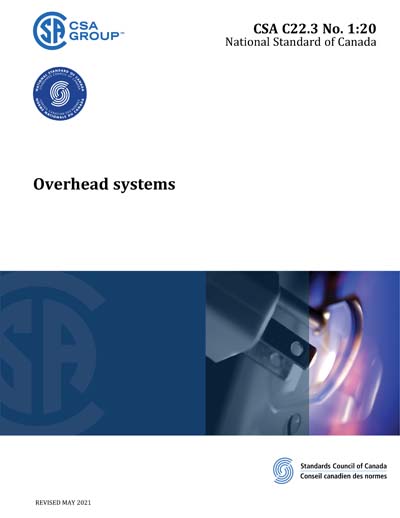Most recent
CSA C22.3 No. 1-2020
Overhead systems
Preface This is the tenth edition of CSA C22.3 No. 1, Overhead systems , one of a series of Standards issued under the Canadian Electrical Code, Part III. It supersedes the previous editions, published in 2010, 2006, 2001, 1987, 1985, 1979, 1976, and 1970, and the original edition, which was published as a series of five Standards in 1959, 1953, 1947, and 1940. Significant changes in this edition include a) The linear design method has been removed from the Standard completing an updating process that was initiated in 2003. b) Definitions and use of terminology have been updated including i) the following new definitions: "pole brace", "rated tensile strength", and "vegetation control cycle"; and ii) revised definitions for "vegetation management" and "communications drop". c) A new clause and guidance in Annex A regarding clearance between supply lines and spray irrigation systems has been included. d) New clauses have been included addressing i) poles with internal supply riser cables; and ii) point of attachment of service conductors at customer premises. e) Clearances between wires crossing each other and supported by different structures (Table 13) have been rationalized and updated. Expanded examples and guidance has been provided in Annex A. f) Coefficients of variation (COV) in the headings of Table 31 specifying load factors for non-linear design of structures have been coordinated with CAN/CSA-O15. g) Clauses dealing with communication circuits used exclusively in the operation of supply lines have been expanded to include communication equipment used exclusively in the operation of supply circuits. h) A clause dealing with assumed transverse load due to wind pressure has been revised to permit reduction in loading for sheltered distribution circuits. i) Clauses dealing with vegetation management, protection against mechanical damage, and assumed longitudinal load have been re-worded to improve clarity. j) Clearances over aerial tramways have been updated. k) Revisions have been made to clauses dealing with obstruction of climbing and working space to improve clarity l) Load factors for guy assembles have been revised to reflect the transition to the non-linear method of analysis. m) Criteria regarding tower head clearances on transmission line structures have been included. n) The Standard has undergone general updating. The reliability-based design of transmission lines is covered by CAN/CSA-C22.3 No. 60826. The purpose of the annexes is to provide the background information and reasoning necessary for the application of this Standard. It is not the intent of the annexes to modify the requirements of any of the clauses in this Standard. Scope 1.1 This Standard applies to electric supply and communication lines and equipment located entirely outside of buildings and fenced supply stations. 1.2 Existing installations (including maintenance replacements and maintenance alterations) meeting the original designs that currently comply with prior editions of this Standard, need not be modified to comply with this edition of the Standard, except as might be required for safety reasons by the authority having jurisdiction. 1.3 This Standard, which forms part of the Canadian Electrical Code, Part III, provides requirements for the construction of overhead systems. It covers electric supply and communication circuits that a) are installed alone; b) are in joint use; c) are in proximity to each other or other facilities; d) cross each other or other facilities; and e) cross railways, highways, navigable waterways, or land that is likely to be traversed by vehicles or pedestrians. 1.4 This Standard presents a choice between deterministic and reliability-based design methods. Reliability-based design methods are covered by CSA C22.3 No. 60826. 1.5 The requirements contained in this Standard do not constitute complete design and construction specifications, but rather prescribe the minimum design requirements that are most important to the a) safety of persons; b) continuity of service; and c) protection of property. 1.6 Conditions not covered by this Standard are governed by equivalent Standards in common use or by the authority having jurisdiction. 1.7 In some cases in this Standard, specific types of construction are envisaged. This does not preclude the use of other types of construction, provided that the engineering representatives involved can demonstrate the safety and suitability of these alternatives. 1.8 The use of terms such as "where practicable" is not intended to provide an opportunity for not meeting the requirements of this Standard, but indicates the preferred clearance or method. Where an alternative is not specified, the engineering solution that most closely adheres to the preferred method should be used. 1.9 Where the requirements of more than one clause apply, all should be satisfied. 1.10 In this Standard, "shall" is used to express a requirement, i.e., a provision that the user is obliged to satisfy in order to comply with the standard; "should" is used to express a recommendation or that which is advised but not required; and "may" is used to express an option or that which is permissible within the limits of the Standard. Notes accompanying clauses do not include requirements or alternative requirements; the purpose of a note accompanying a clause is to separate from the text explanatory or informative material. Notes to tables and figures are considered part of the table or figure and may be written as requirements. Annexes are designated normative (mandatory) or informative (non-mandatory) to define their application.
Content Provider
CSA America, Inc. [csa]






